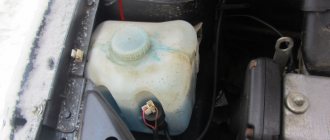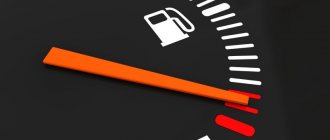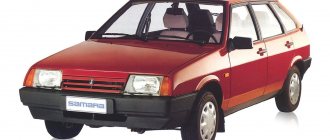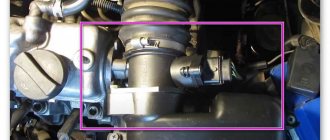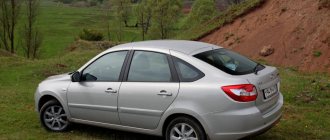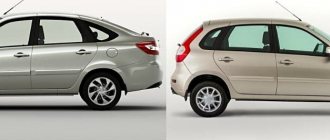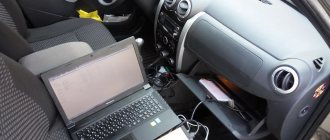The main indicator of economical operation of a car engine is specific fuel consumption. There are several methods for determining it. Every manufacturer wants their cars to have this figure as low as possible. Therefore, the methods for determining gasoline consumption differ from one another. The Russian manufacturer represented by AvtoVAZ claims that the fuel consumption of the Lada Granta averages 6.7-7.7 l/100 km in the combined driving cycle. However, passport data does not always coincide with actual results.
How are fuel consumption standards determined?
Gasoline consumption is determined in laboratory conditions. There are special techniques for this. For example, in Europe, consumption is determined according to NEDC standards - the new European driving cycle. The standard was last updated in 1997. Its disadvantage is that the choice of vehicle and test conditions is at the discretion of the automaker. Instead of a new car, a run-in version of the tested model can be used and almost perfect conditions created for this (windows closed, air conditioning, headlights and MMC turned off, etc.).
To simulate driving in the city and on the highway, different testing times are selected. Special rubber and low viscosity lubricating oil may be used. The presence of these factors leads to the fact that gasoline consumption standards appear in the car's passport, which are far from the true ones. The American and Japanese methods are more stringent, so the documents indicate values that are close to objective. In some cases, if you buy a car with a passport consumption of 7.5 liters per 100 km, in reality it turns out that it consumes 10-12 liters. This figure may increase depending on the season, fuel quality, load, road and engine conditions and many other factors. Therefore, drivers themselves try to determine specific fuel consumption and take measures to reduce it.
Standard
The designers of the Volzhsky Automobile Plant confidently say that, according to the driving cycle, the Grant will burn approximately 7 liters of gasoline over a hundred kilometers. This volume is required, in particular:
- sedan;
- liftback.
At the same time, Granta Sport consumes only 6.8 liters according to the norm.
Not everyone understands what a drive cycle means. You should know that this is a kind of theoretical route in which everything without exception is precisely calculated:
- braking;
- acceleration;
- duration of the ride;
- its intensity;
- speed is both minimum and maximum possible.
If the car is equipped with a manual transmission rather than an automatic transmission, then the gear for each time segment of the driving cycle is also taken into account.
That is, in fact, such a route is nothing more than a theoretical construction that takes into account the manner of movement in populated areas, on rough terrain, and so on.
What factors influence the fuel consumption of the Lada Granta?
Fuel consumption when driving under standard conditions depends on the following factors and is:
- driving - 60%;
- operation at full air conditioner power - 15%;
- driving on a cold engine - 12%;
- traveling with lights on - 5%;
- open windows at speeds over 50 km/h - 4%;
- low tire pressure - 4%.
Gasoline consumption on the Lada Granta may increase due to:
- low quality fuel;
- using tires that are not appropriate for the season;
- unsatisfactory condition of the engine and systems serving it;
- aggressive driving style;
- condition of the road surface;
- use of powerful additional electrical equipment;
- installing a trunk, air box or driving with a trailer.
In winter, when the engine warms up, fuel consumption increases by 1.5-2 liters. Driving around the city during rush hour significantly increases fuel consumption. In some cases, consumption can reach 15-19 l/100 km.
Using gasoline with a low octane number not only increases its consumption, but also leads to engine overheating.
Highway congestion
Driving around the city, as a rule, is seriously hampered by the abundance of cars on the streets.
This constantly leads to traffic jams. As a result, engine operation requires more gasoline. The situation is aggravated in winter and summer, when you also need to either heat the car interior or cool it.
In total, consumption can increase significantly under the influence of all the previously mentioned factors.
Fuel consumption of 8-valve engines
The first copies of the Lada Granta, which appeared in 2011, were equipped with gasoline injection engines models 11183 and 11186 with a volume of 1.6 liters and a power of 82 and 87 hp. respectively. The use of a power supply system with distributed injection and a lightweight connecting rod and piston group made it possible to achieve a reduction in consumption in all driving modes. With a combined cycle, the 82-horsepower Lada Granta has a gasoline consumption of 7.4 liters, and with the 11186 engine - 7.0 liters per 100 km. When driving in the city it will be 9.7 and 9.0 l/100 km, and on the highway - 6.1 and 5.8 l/100 km, respectively.
In fact, the fuel consumption of the sedan differs significantly from the official data: outside the city it is about 6.6 liters, and in the combined cycle - 8.5 l/100 km. Differences in fuel consumption largely depend on the operation of the vehicle under conditions that differ significantly from laboratory conditions (ground tests). The use of low quality fuel and lubricants makes a significant contribution.
Sedan and liftback body
The Lada Granta sedan went on sale in 2011 and immediately became a popular car model. The reason for this was the massive purchases of this particular car: two years after its release, every 15 purchased car was a Lada Granta sedan. Of the three known trim levels - Standard, Normal and Luxury, the most affordable option is the standard. The engine capacity is 1.6 liters and the power is 82 hp. With. makes this 4-door model not only a budget, but also a practical economy class car. And the average gasoline consumption of the Lada Granta sedan is 7.5 liters per 100 kilometers.
Before the release of the new Lada model, many became interested in how much it would change. As a result, the technical characteristics of the liftback are not very different from the sedan. This car entered the market in 2014. The main changes are visible in the exterior of the car and in the 5-door configuration. Other functional devices remained the same or were improved. The lack of changes can be seen on the car configuration, which was transferred from the Grant sedan. Fuel consumption in such cars is slightly higher, as engine power has increased.
Fuel consumption of 16-valve engines
Installing 4 valves per cylinder made it possible to reduce the load on the engine, which had a positive effect on reducing fuel consumption and at the same time increasing the power of the power unit. The cars were equipped with engines 21126 (98 hp) and 21127 (106 hp) with a volume of 1.6 liters. Frets with such engines had both a mechanical and a robotic gearbox. According to the passport data, fuel consumption standards per 100 km for cars with a 98 hp power unit. are:
- urban cycle - 9.9 l;
- highway - 6.1 l;
- mixed cycle - 7.6 l.
Despite the fact that the 21127 engine has more power, it consumes slightly less fuel:
- city roads - 8.6 l;
- highway - 5.6 l;
- mixed cycle - 6.7 l.
Actual costs differ from the passport costs and amount to 10-12 liters for the city and 7 -7.5 liters when driving on suburban highways.
Driving style
Fuel consumption also largely depends on it.
Fans of speed and spectacular starts with sudden stops spend more fuel than calm car owners. Moreover, when the driver constantly starts with a cold engine, the amount of gasoline burned usually increases by approximately 12 percent.
As previously noted, the operation of various electronic systems, including air conditioning, also requires fuel. The more gadgets and gadgets installed on a car, the more difficult it is to save gas.
Only one air conditioner can “eat” an additional 15 percent of the total volume.
Features of consumption depending on the gearbox
Cars with an automatic transmission (automatic transmission) consume more fuel than those with a manual transmission (manual transmission).
This is due to the fact that the robot switches gears with a delay, i.e., to switch to a higher gear, higher engine speeds are required than with a manual transmission.
This is especially noticeable when driving within the city. Gasoline consumption for cars with automatic transmission in this case is 11-12 l/100 km. On the highway, these figures are slightly lower and fluctuate between 7.5-8.5 l/100 km. In winter, gasoline costs increase by 2-2.5 l/100 km. On cars with a manual transmission, fuel consumption under the same conditions is 2-3 liters less.
Due to the high cost and high fuel costs, cars with a robotic gearbox are in less demand among potential Lada Granta owners.
Why did it happen so?
Perhaps the automatic requests do not belong to you, but to another user accessing the network from the same IP address as you. You need to enter the characters into the form once, after which we will remember you and be able to distinguish you from other users exiting from this IP. In this case, the page with the captcha will not bother you for quite a long time.
You may have add-ons installed in your browser that can make automatic search requests. In this case, we recommend that you disable them.
It is also possible that your computer is infected with a virus program that is using it to collect information. Maybe you should check your system for viruses.
If you have any problems or would like our support team, please use the feedback form.
Lada Granta is a direct descendant of Lada Kalina; production of this model began in mid-2011, and first sales started in December of the same year. Budget front-wheel drive sedans and liftbacks are representatives of the C-class. A station wagon is planned for release in 2021. Assembly takes place at Russian car factories and in Kazakhstan. A variation of the Lada Granta Sport model takes part in racing competitions. Production continues to this day.
How to measure fuel consumption yourself
On car enthusiast forums you can often find messages that their Ladas consume from 14 to 18 l/100 km when driving around the city or 8-9 l when driving outside the city. Despite the presence of an on-board computer, many car owners try to calculate specific fuel consumption themselves. It happens that the result is less than the computer readings, and sometimes vice versa. In this case, you must contact a service station to diagnose the engine.
Test lamp method
To ensure accurate fuel consumption measurements, you must drive at least 1 thousand km. When the minimum fuel reserve warning light comes on, less than 7 liters of gasoline remains in the tank. The car is filled with fuel until the gas tank is full. After this, the odometer is reset, and the car is operated in everyday mode until the light comes on. The car is filled with AI 95 gasoline and so on until the mileage is 1 thousand km. After the next signal lights up, readings are taken and the average fuel consumption is determined.
The calculation is carried out using the formula: (V/L)x100, where V is the total amount of gasoline filled, and L is the control mileage of the car. If the result differs from the passport data and exceeds 10 liters, check the serviceability of the systems. To do this, the on-board computer readings are reset and a test drive is carried out on an open road at a constant speed of 80-90 km/h.
The mileage per trip should be 5-10 km. If, as a result of measurements, the consumption according to the on-board computer is in the range of 4.5-5.5 liters, it means that the engine is working normally, and the increased fuel consumption is associated with driving style or the congestion and condition of the roads. Otherwise, you need to contact a car service.
From tank to tank
With this method of determining the average fuel consumption, the result is less accurate than in the previous one, but it will qualitatively show the excess or value of the specified fuel consumption. To do this, the odometer and computer readings are reset, and the fuel tank is filled up to the neck so that the gasoline level is visible. The vehicle must travel at least 300 km in various modes. The longer the mileage, the more accurate the result will be.
After all the gasoline has been used up, the car is refueled to the same level as before taking measurements. The average consumption is determined by the same formula as in the previous case. The calculated data is compared with computer readings. If the difference is large, then it is necessary to check the readings and, if necessary, calibrate the fuel consumption on the device.
Measurement results may vary due to the quality of gasoline. Therefore, it is recommended to carry out measurements while replenishing fuel at one gas station. In case of increased consumption, you need to measure it while refueling at a gas station of another network.
Is it comfortable to sit?
The front seats are a compromise. Relatively high rise, not very long cushion, but overall decent back support. However, after restyling, the chairs became more pleasing to the eye, but less pleasing to the back and legs. The old-style padding was a little more comfortable - on a long journey the desire to stretch did not come as often. And of course, restyling did not correct the main drawback of the rear of the Granta - the narrow space in the area of the lower part of the doorways. But this inconvenience of getting on/off is an inevitable price to pay for stamping the floor under a large fifty-liter tank.

